
DESERT HIKES
Washington


DESERT HIKES
Washington
Alan Bauer
Dan A. Nelson

 | THE MOUNTAINEERS BOOKS
is the nonprofit publishing arm of The Mountaineers, an organization founded in 1906 and dedicated to the exploration, preservation, and enjoyment of outdoor and wilderness areas. |
1001 SW Klickitat Way, Suite 201, Seattle, WA 98134
2004 by Dan A. Nelson and Alan L. Bauer
All rights reserved.
First edition: first printing 2004, second printing 2009, third printing 2011
No part of this book may be reproduced in any form, or by any electronic, mechanical, or other means, without permission in writing from the publisher.
Distributed in the United Kingdom by Cordee, www.cordee.co.uk
Manufactured in the United States of America
Acquiring Editor: Christine U. Hosler, Project Editor: Kate Rogers, Copy Editor: Heath Lynn Silberfeld, Cover and Book Design: The Mountaineers Books, Layout Artist: Ani Rucki, Cartographer: Ben Pease
Maps shown in this book were produced using National Geographics TOPO! software. For more information, go to www.nationalgeographic.com/topo.
Unless otherwise noted, all photographs by Alan Bauer
Cover photograph: Balsamroot and other flowers cover the rocky slopes of Selah Butte. Frontispiece: Clump of blooming Bitterroot (Lewisia rediviva) on Manastash Ridge : A huge inlet waterfall crashes down the basalt cliffs into one of the potholes at Ancient Lake.
Library of Congress Cataloging-in-Publication Data
Nelson, Dan.
Best desert hikes : Washington / Dan Nelson and Alan Bauer. 1st ed.
p. cm.
Includes index.
ISBN 978-0-89886-929-3 (ebook)
ISBN 0-89886-537-9 (pbk.)
1. HikingWashington (State)Guidebooks. 2. Washington (State)Guidebooks. I. Bauer, Alan. II. Title.
GV199.42.W2.N43 2004
796.5109797dc22
2004012712
 Printed on recycled paper
Printed on recycled paper
CONTENTS


HIKES AT A GLANCE






PREFACE
I have a special affinity for the sagebrush and rimrock of the far southeast corner of Washington, having grown up hiking, hunting, and fishing in the open country there. That dry country is a far cry from the moisture-rich forests of the Olympics and western Cascades, but it is just as much a part of Washington as are the emerald forests of those mountains.
The popular image of stark, barren strands of blowing desert sand doesnt work as a definition for Washingtons desert country. Nothing barren or lifeless characterizes this desert. Rather, the dry landscape is rich in both plant and animal life. Sun-loving desert plants add color to the already multihued earth. The black and russet rocks and soils are painted each spring and summer with the vibrant blues, purples, yellows, oranges, whites, and reds of wildflowers bursting into bloom. The deep gullies, high ridges, and long rolling plateaus echo with the calls of coyotes, the screams of raptors, and the thump, thump, thump of deer, elk, and bighorn sheep bounding across the landscape. Yes, this is desert, but it is vibrant and intensively beautiful.
The open country east of the Cascades and west of the Rockies sees rain only rarely, but life in great diversity has taken hold here. This land features upland plateaus, sagebrush steppes, dry coulees, and richly vegetated canyons. Running through the heart of this scenic and varied landscape is the mighty Columbia River. Indeed, most of central Washington comprises the Upper Columbia River Basin. From the Tri-Cities to Canada, the Columbia is the central artery through this arid country.
This oft-overlooked part of Washington contains much more than the river, though, and offers some of the most scenic, grandiose country in all of the majestic Pacific Northwest. The massive black basalt walls of Dry Fallsonce (following the last great Ice Age) the largest waterfall on the planet and now just a series of dripping cliffsdrop away from the upland flats south of Banks Lake. The steep, rimrock-lined canyons of Swakane Canyon offer refuge to mule deer, bighorn sheep, coyotes, and cougars. Black bears occasionally roam the wild, remote canyons. The rolling hills of the Columbia National Wildlife Refuge flank the last untamed stretch of the wild Columbia along the Hanford Reach. The ravines and draws above Palouse Falls boast literal forests of sagebrushbushes that tower 6, 10, even 15 feet over the sandy canyon floors. In spring, the entire desert country explodes in color as a plethora of wildflowersfrom balsamroot to bitterrootblossom in the sun.
The broad flatland between the Cascades and the Rockies of Idaho offers wonderful wintertime fun for snow-weary hikers. This part of eastern Washington seldom sees snow of any significance, and what light dustings it does receive merely serve to enhance the stark beauty of the landscape without hindering the hiking opportunities. Washingtons desert country is prime winter hiking country.
This varied landscape, full of plants and animals, is a dynamic, exciting part of the state, ripe for recreational exploration. Deserts, yesbut not the Lawrence of Arabia sort. While eastern Washingtons desert shares the sun and heat common to that sand-swept image, it is full of life.
In short, the area described in this book is one of the richest, most varied ecosystems in the state. Enjoy your explorations there.
Dan A. Nelson

Western bluebird pauses on a fencepost, Umtanum Ridge, L.T. Murray State Wildlife Recreation Area.
INTRODUCTION

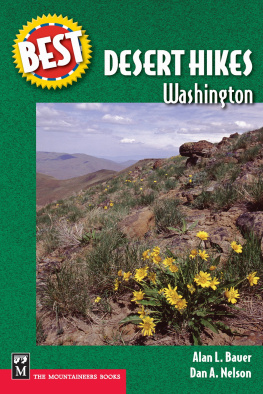


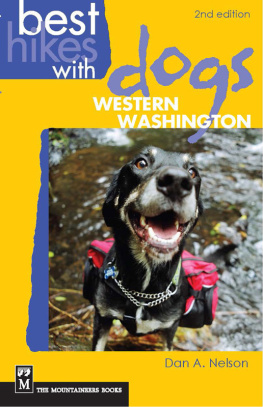

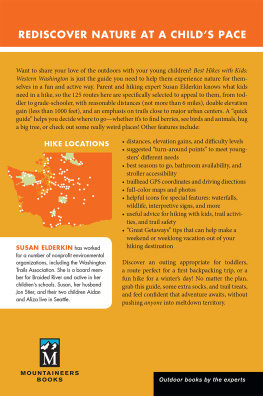
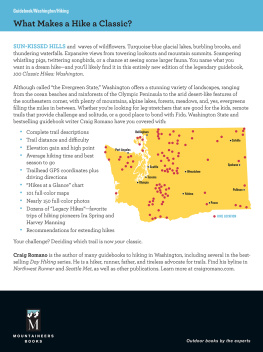
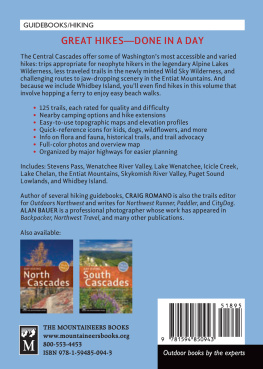





 Printed on recycled paper
Printed on recycled paper







